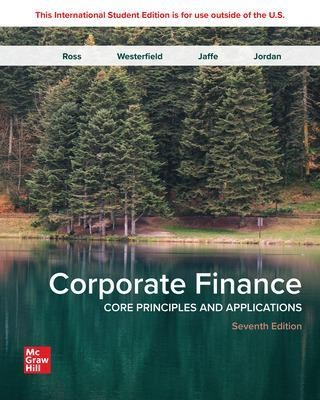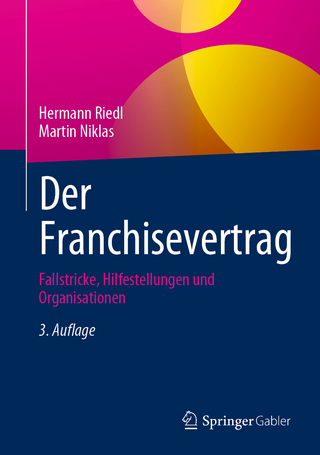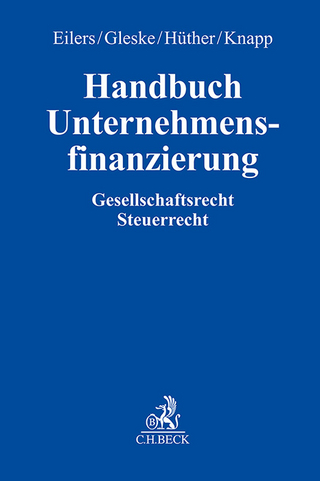
Corporate Finance: Core Principles and Applications ISE
McGraw-Hill Education (Verlag)
978-1-266-19158-9 (ISBN)
Stephen A. Ross was the Franco Modigliani Professor of Financial Economics at the Sloan School of Management, Massachusetts Institute of Technology. One of the most widely published authors in finance and economics. Professor Ross is recognized for his work in developing the arbitrage pricing theory, along with his substantial contributions to the discipline through his research in signaling, agency theory, option pricing, and the theory of the term structure of interest rates, among other topics. A past president of the American Finance Association, he also served as an associate editor of several academic and practitioner journals, and was a trustee of CalTech. Randolph W. Westerfield is Dean Emeritus of the University of Southern California’s Marshall School of Business and is the Charles B. Thornton Professor of Finance Emeritus. Professor Westerfield came to USC from the Wharton School, University of Pennsylvania, where he was the chairman of the finance department and member of the finance faculty for 20 years. He is a member of the Board of Trustees of Oaktree Capital Mutual Funds. His areas of expertise include corporate financial policy, investment management, and stock market price behavior. Jeffrey F. Jaffe has been a frequent contributor to finance and economic literature in such journals as the Quarterly Economic Journal, The Journal of Finance, The Journal of Financial and Quantitative Analysis, The Journal of Financial Economics, and The Financial Analysts Journal. His best-known work concerns insider trading, where he showed both that corporate insiders earn abnormal profits from their trades and that regulation has little effect on these profits. He has also made contributions concerning initial public offerings, the regulation of utilities, the behavior of market makers, the fluctuation of gold prices, the theoretical effect of inflation on the interest rate, the empirical effect of inflation on capital asset prices, the relationship between small-capitalization stocks and the January effect, and the capital structure decision. Bradford D. Jordan is Visiting Scholar at the University of Florida. He previously held the duPont Endowed Chair in Banking and Financial Services at the University of Kentucky, where he was department chair for many years. He specializes in corporate finance and securities valuation. He has published numerous articles in leading finance journals, and he has received a variety of research awards, including the Fama/DFA Award in 2010.Dr. Jordan is coauthor of Corporate Finance 13e, Corporate Finance: Core Principles and Applications 7e, Fundamentals of Corporate Finance 13e, and Essentials of Corporate Finance 1le, which collectively are the most widely used business finance textbooks in the world, along with Fundamentals of Investments: Valuation and Management 10e, a popular investments text.
PART ONE: OVERVIEW
Chapter One: Introduction to Corporate Finance
Chapter Two: Financial Statements and Cash Flow
Chapter Three: Financial Statements Analysis and FinancialModels
PART TWO: VALUATION AND CAPITAL BUDGETING
Chapter Four: Discounted Cash Flow Valuation
Chapter Five: Interest Rates and Bond Valuation
Chapter Six: Stock Valuation
Chapter Seven: Net Present Value and Other Investment Rules
Chapter Eight: Making Capital Investment Decisions
Chapter Nine: Risk Analysis, Real Options, and CapitalBudgeting
PART THREE: RISK AND RETURN
Chapter Ten: Risk and Return: Lessons from Market History
Chapter Eleven: Return and Risk: The Capital Asset PricingModel (CAPM)
Chapter Twelve: Risk, Cost of Capital, and Valuation
PART FOUR: CAPITAL STRUCTURE AND DIVIDEND POLICY
Chapter Thirteen: Efficient Capital Markets and BehavioralChallenges
Chapter Fourteen: Capital Structure: Basic Concepts
Chapter Fifteen: Capital Structure: Limits to the Use ofDebt
Chapter Sixteen: Dividends and Other Payouts
PART FIVE: SPECIAL TOPICS
Chapter Seventeen: Options and Corporate Finance
Chapter Eighteen: Short-Term Finance and Planning
Chapter Nineteen: Raising Capital
Chapter Twenty: International Corporate Finance
Chapter Twenty-One: Mergers and Acquisitions (web only)
APPENDIXES
A: Mathematical Tables
B: Solutions to Selected End-of-Chapter Problems
C: Using the HP 10B and TI BA II Plus FinancialCalculators
D: Key Equations
| Erscheinungsdatum | 08.03.2023 |
|---|---|
| Zusatzinfo | 160 Illustrations |
| Verlagsort | OH |
| Sprache | englisch |
| Maße | 201 x 254 mm |
| Gewicht | 1093 g |
| Themenwelt | Wirtschaft ► Betriebswirtschaft / Management |
| ISBN-10 | 1-266-19158-5 / 1266191585 |
| ISBN-13 | 978-1-266-19158-9 / 9781266191589 |
| Zustand | Neuware |
| Haben Sie eine Frage zum Produkt? |
aus dem Bereich


